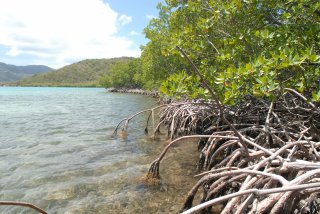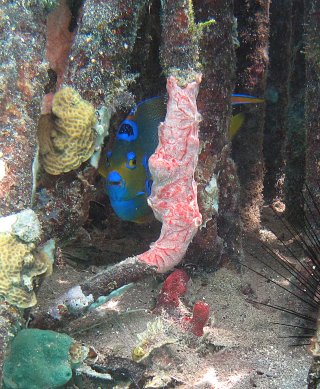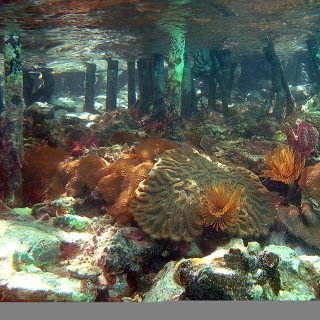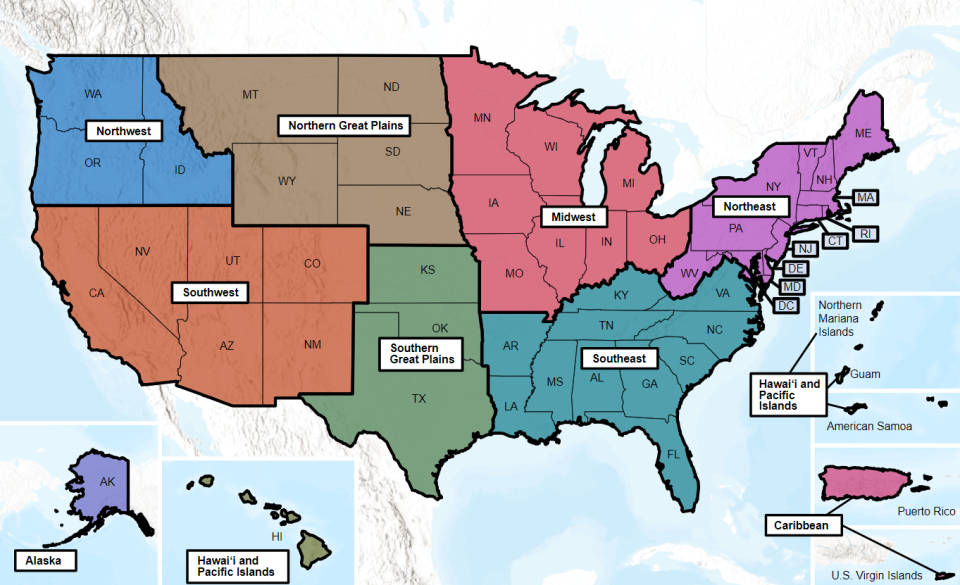Climate Change Connections: U.S. Virgin Islands (Mangroves)
Climate change is impacting all regions and sectors of the United States. The State and Regional Climate Change Connections resource highlights climate change connections to culturally, ecologically, or economically important features of each state and territory. The content on this page provides an illustrative example. As climate change will affect each state and territory in diverse ways, this resource only describes a small portion of these risks. For more comprehensive information about regional climate impacts, please visit the Fifth National Climate Assessment and Climate Change Impacts by Sector.
On this page:
Introduction: Mangroves Support Important Marine Ecosystems

The U.S. Virgin Islands (USVI), a territory of the United States, is part of the Virgin Islands archipelago in the Caribbean.1 Known for their beautiful beaches and ecotourism activities, the islands attract many visitors and tourism is a key driver in the local economy. In 2022 alone, more than 1.8 million tourists visited the islands.2 In addition to its iconic sandy beaches, the USVI are home to a number of important ecosystems, including coral reefs, subtropical forests, seagrass beds, and mangroves.3–5 Mangroves provide important ecosystem benefits, such as nutrient filtration, shoreline protection, water and air quality preservation, and recreation.6 They also provide important habitat for marine and terrestrial wildlife.
By retaining sediment in their roots, mangroves stabilize shorelines, helping to protect coastal communities from flooding and erosion.6,7 Mangrove roots also have the ability to trap and filter sediment and runoff, including heavy metals, that are harmful to coral reefs.8,9 Known as a “blue carbon” ecosystem, mangroves absorb carbon dioxide from the atmosphere and store it in their roots, leaves, and soils, which offsets overall carbon dioxide emissions and helps to mitigate climate change.6,8,10

The USVI are home to a unique coexisting mangrove-coral ecosystem located in the four mangrove-lined bays of Hurricane Hole, St. John.11 Though mangroves are often viewed as an unsuitable habitat for coral, the mangroves in Hurricane Hole support a thriving coral ecosystem, while neighboring reefs have experienced large declines.11–13 Scientists believe this could be because the mangroves offer shade to the coral, reducing stressors like heat.12 More than 30 coral species have been identified growing on or near mangrove prop roots (arching roots that descend from the trunk and branches into the water) in Hurricane Hole.12 In 2005 and 2006, the tropical Atlantic and Caribbean experienced record losses of coral reefs due to high ocean temperatures.14 The size of many coral colonies in Hurricane Hole indicate that they survived these catastrophic bleaching and disease events, leading scientists to believe the mangroves provide other species with refuge from the impacts of climate change.11,12,15
Climate Impacts: Increased Hurricane Intensity Could Continue to Harm Mangroves
Numerous hurricanes have already impacted islands in the Caribbean and their mangrove ecosystems.5,16 In 2017, Hurricanes Irma and Maria hit the USVI less than two weeks apart, causing widespread devastation, thousands of deaths, and billions of dollars in damages across the Caribbean.5 The storms disrupted coastal ecosystems, damaging roughly 33 percent of mangroves on neighboring island Puerto Rico.5 Five months after the hurricanes, an assessment of the conditions of the mangrove ecosystems in the Virgin Islands Coral Reef National Monument revealed destruction of mangrove prop roots (uprooted or stripped) and a significant decline in marine biodiversity.17 This assessment also noted a loss of shade from the mangrove trees, which could have implications for the species that depend on them.17
Climate change is predicted to increase the intensity of and the damage caused by these types of weather events.5 This could lead to additional defoliation (premature falling of leaves), tree mortality, and loss of mangrove area.6 The magnitude of the damage could hinder the mangroves’ ability to provide important ecosystem benefits in the future.
Climate Impacts: Sea Level Rise Could Impact Mangrove Distribution
Warming temperatures are causing global sea levels to rise. The two key ways warming temperatures impact sea level is through the addition of water from melting land ice (like glaciers and ice sheets) and the expansion of water due to warming ocean temperatures.18 By 2100, sea levels surrounding the USVI are expected to rise significantly, with a projected range of 1 to 4 feet (possibly up to 8 feet), depending on concentrations of greenhouse gases in the atmosphere.19 Mangroves along the coast are vulnerable to sea level rise, which can impact their productivity, health, and ability to support the ecosystem.20 Though mangroves have the ability to increase their surface elevation by trapping sediment in their roots, this resilience depends on a variety of factors, including whether the natural buildup of sediment (known as accretion) is greater than sea level rise and whether neighboring land space is available for their migration.7,20 If their path is obstructed, such as by infrastructure (e.g., buildings) and the mangroves cannot migrate, a rise in sea level has the potential to impact their overall distribution.6
Taking Action: Protecting Reefs in Warming, Rising Seas
Addressing climate change requires reducing greenhouse gas emissions while preparing for and protecting against current and future climate impacts. Communities, public officials, and individuals in every part of the United States can continue to explore and implement climate adaptation and mitigation measures. Mangroves play an important role in both climate change mitigation and adaptation. Natural resource managers and organizations in the USVI are collaborating to implement strategies to preserve and protect mangroves, including:

Community involvement and education. Community involvement in mangrove restoration efforts can help spread awareness about preserving these ecosystems. The University of the Virgin Islands has implemented various programs to educate community members and encourage participation in the protection, restoration, and research of mangroves.21 For example, the Mangrove Restoration Project is a citizen science program where volunteers and researchers collect, grow, and replant mangroves, as well as record and analyze data to improve mangrove survival rates.21 The University of the Virgin Islands has also partnered with various federal agencies and nonprofit organizations to create a variety of learning opportunities for students, including the hands-on Mangroves in the Classroom program.22
Habitat protection and restoration. Continued protection of mangrove trees is imperative in maintaining the health of ecosystems and the benefits they provide.9 Mangroves are protected under the USVI Endangered and Indigenous Species Act.23 The USVI has designated five marine protected areas, six marine reserves and wildlife sanctuaries, and 18 areas of particular concern.4 Coral Bay, where Hurricane Hole is located, is included in the Virgin Islands Coral Reef National Monument, which protects the ecologically significant mangroves that line the bays.4 Virgin Islands National Park, one of the designated marine protected areas, restores shorelines by planting mangroves and propagating coral.24 The park also actively monitors how marine protected areas affect specific species’ populations.4
To learn more about climate change impacts in the U.S. Virgin Islands and the other U.S. Caribbean Islands, see Chapter 23 of the Fifth National Climate Assessment.
Related Resources
- EPA Climate Change Indicators: Tropical Cyclone Activity
- EPA Climate Change Indicators: Sea Level
- Puerto Rico and the U.S. Virgin Islands State Climate Summary 2022 (NOAA)
- Fifth National Climate Assessment: Chapter 9: Coastal Effects
References
1 Coral Reef Information System. (2023). U.S. Virgin Islands. NOAA. Retrieved November 24, 2023, from https://www.coris.noaa.gov/portals/virginislands.html
2 U.S. Virgin Islands Bureau of Economic Research. (2022). Annual tourism indicator. https://usviber.org/wp-content/uploads/2023/12/Tourism-indicator-2022-12-28-23-1.pdf
3 Hall, K., & KellerLynn, K. (2010). Virgin Islands National Park: Geologic resources inventory report (Natural Resource Report NPS/NRPC/GRD/NRR—2010/226). Natural Resource Program Center. https://irma.nps.gov/DataStore/Reference/Profile/2124890
4 Pittman, S. J., Bauer, L., Hile, S. D., Jeffrey, C. F. G., Davenport, E., & Caldow, C. (2014). Marine protected areas of the US Virgin Islands ecological performance report (NOAA Technical Memorandum NOS NCCOS 187). Center for Coastal Monitoring and Assessment, NOAA National Centers for Coastal Ocean Science. https://www.coris.noaa.gov/activities/usvi_ecological_report/welcome.html
5 Méndez-Lazaro, P. A., Chardón-Maldonado, P., Carrubba, L., Álvarez-Berríos, N., Barreto, M., Bowden, J. H., Crespo-Acevedo, W. I., Diaz, E. L., Gardner, L. S., Gonzalez, G., Guannel, G., Guido, Z., Harmsen, E. W., Leinberger, A. J., McGinley, K., Méndez-Lazaro, P. A., Ortiz, A. P., Pulwarty, R. S., Ragster, L. E., … Vila-Biaggi, I. M. (2023). Ch. 23. US Caribbean. In A. R. Crimmins, C. W. Avery, D. R. Easterling, K. E. Kunkel, B. C. Stewart, & T. K. Maycock (Eds.), . U.S. Global Change Research Program. https://doi.org/10.7930/NCA5.2023.CH23
6 Wang, Y.-S., & Gu, J.-D. (2021). Ecological responses, adaptation and mechanisms of mangrove wetland ecosystem to global climate change and anthropogenic activities. International Biodeterioration & Biodegradation, 162, 105248. https://doi.org/10.1016/j.ibiod.2021.105248
7 Menéndez, P., Losada, I. J., Torres-Ortega, S., Narayan, S., & Beck, M. W. (2020). The global flood protection benefits of mangroves. Scientific Reports, 10(1), 4404. https://doi.org/10.1038/s41598-020-61136-6
8 Renata J. Platenberg & Jennifer M. Valiulis. (2018). United States Virgin Islands Wildlife Action Plan. Final Report to the USVI Department of Planning and Natural Resources Division of Fish and Wildlife, 2. https://dpnr.vi.gov/wp-content/uploads/2022/10/VI-WAP-Vol-2-Habitats-Species.pdf
9 Sandilyan, S., & Kathiresan, K. (2012). Mangrove conservation: a global perspective. Biodiversity and Conservation, 21(14), 3523–3542. https://doi.org/10.1007/s10531-012-0388-x
10 Chatting, M., Al-Maslamani, I., Walton, M., Skov, M. W., Kennedy, H., Husrevoglu, Y. S., & Le Vay, L. (2022). Future mangrove carbon storage under climate change and deforestation. Frontiers in Marine Science, 9, 781876. https://doi.org/10.3389/fmars.2022.781876
11 Rogers, C. (2017). A unique coral community in the mangroves of Hurricane Hole, St. John, US Virgin Islands. Diversity, 9(3), 29. https://doi.org/10.3390/d9030029
12 Yates, K. K., Rogers, C. S., Herlan, J. J., Brooks, G. R., Smiley, N. A., & Larson, R. A. (2014). Diverse coral communities in mangrove habitats suggest a novel refuge from climate change. Biogeosciences, 11(16), 4321–4337. https://doi.org/10.5194/bg-11-4321-2014
13 Stewart, H. A., Kline, D. I., Chapman, L. J., & Altieri, A. H. (2021). Caribbean mangrove forests act as coral refugia by reducing light stress and increasing coral richness. Ecosphere, 12(3), e03413. https://doi.org/10.1002/ecs2.3413
14 Eakin, C. M., Morgan, J. A., Heron, S. F., Smith, T. B., Liu, G., Alvarez-Filip, L., Baca, B., Bartels, E., Bastidas, C., Bouchon, C., Brandt, M., Bruckner, A. W., Bunkley-Williams, L., Cameron, A., Causey, B. D., Chiappone, M., Christensen, T. R. L., Crabbe, M. J. C., Day, O., … Yusuf, Y. (2010). Caribbean corals in crisis: Record thermal stress, bleaching, and mortality in 2005. PLoS ONE, 5(11), e13969. https://doi.org/10.1371/journal.pone.0013969
15 Rogers, C. S. (2009). High diversity and abundance of scleractinian corals growing on and near mangrove prop roots, St. John, US Virgin Islands. Coral Reefs, 28(4), 909–909. https://doi.org/10.1007/s00338-009-0526-4
16 Krauss, K. W., Whelan, K. R. T., Kennedy, J. P., Friess, D. A., Rogers, C. S., Stewart, H. A., Grimes, K. W., Trench, C. A., Ogurcak, D. E., Toline, C. A., Ball, L. C., & From, A. S. (2023). Framework for facilitating mangrove recovery after hurricanes on Caribbean islands. Restoration Ecology, 31(7), e13885. https://doi.org/10.1111/rec.13885
17 Rogers, C. (2019). Immediate effects of hurricanes on a diverse coral/mangrove ecosystem in the U.S. Virgin Islands and the potential for recovery. Diversity, 11(8), 130. https://doi.org/10.3390/d11080130
18 Leung, L. R., Terando, A., Joseph, R., Tselioudis, G., Bruhwiler, L. M., Cook, B., Deser, C., Hall, A., Hamlington, B. D., Hoell, A., Hoffman, F. M., Klein, S., Naik, V., Pendergrass, A. G., Tebaldi, C., Ullrich, P. A., & Wehner, M. F. (2023). Ch. 3. Earth systems processes. In A. R. Crimmins, C. W. Avery, D. R. Easterling, K. E. Kunkel, B. C. Stewart, & T. K. Maycock (Eds.), Fifth National Climate Assessment. U.S. Global Change Research Program. https://doi.org/10.7930/NCA5.2023.CH3
19 Runkle, J., Kunkel, K. E., Stevens, L. E., Champion, S. M., Easterling, D. R., Terando, A., Sun, L., Stewart, B. C., Landers, G., & Rayne, S. (2022). Puerto Rico and the U.S. Virgin Islands state climate summary 2022 (NOAA Technical Report NESDIS 150-PR). NOAA National Environmental Satellite, Data, and Information Service. https://statesummaries.ncics.org/chapter/pr/
20 Ward, R. D., & De Lacerda, L. D. (2021). Chapter 10: Responses of mangrove ecosystems to sea level change. In Dynamic Sedimentary Environments of Mangrove Coasts (pp. 235–253). Elsevier. https://doi.org/10.1016/B978-0-12-816437-2.00002-1
21 University of the Virgin Islands. (n.d.). Mangrove restoration project. Retrieved November 15, 2023, from https://www.uvi.edu/community/virgin-islands-marine-advisory-service/mangrove-restoration-project.html
22 Virgin Islands Established Program to Stimulate Competitive Research. (2021). Mangroves in the classroom: A climate resilience project in St Thomas, U.S. Virgin Islands. Retrieved July 25, 2024, from https://www.viepscor.org/videos/v/mangroves-in-the-classroom-usvi
23 McKayle, C., Guannel, G., Taylor, M., & Stephenson, T. (2019). Climate change adaptation planning assessment and implementation: Final vulnerability and risk assessment report. University of the Virgin Islands and University of the West Indies, Mona. https://www.doi.gov/sites/doi.gov/files/1.-usvi-climate-vulnerability-and-risk-assessment-report-final.pdf
24 National Park Service. (n.d.). Shoreline restoration. Virgin Islands National Park. Retrieved November 15, 2023, from https://www.nps.gov/viis/learn/management/shoreline-restoration.htm

